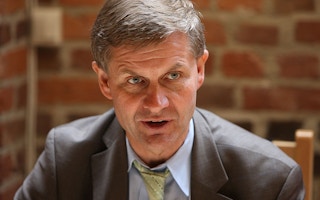Only a few months before the 2017 UN climate conference in Bonn, Germany, some of the most devastating environmental disasters the world has seen occurred after intense rains caused severe flooding in South Asia, and Hurricanes Harvey, Irma and Maria led to unprecedented flooding and damage in the Caribbean and the United States.
“We see Mother Earth fighting back,” said Erik Solheim, head of the UN Environment Programme (UNEP), in a recent speech, making reference to the intensity of the deadly storms, widely attributed to climate change.
“Climate change is a reality that threatens the future of life on Earth,” said Solheim, who will deliver a keynote speech at the Global Landscapes Forum in Bonn on Dec. 19.
Keeping average global temperatures well below 2 degrees Celsius in relation to pre-industrial levels to meet guidelines agreed at UN climate talks in Paris in 2015 is vital, but we must also address the challenge of air pollution caused by greenhouse gases, other pollutant gases, nitrogen oxides and sulfur dioxide, said Solheim, who, since joining UNEP in 2016, has established a renewed emphasis on addressing pollution in all its forms.
“Pollution has serious consequences for human health, the environment and the economy,” Solheim said. “The main sources of pollution include industrial activities, the transport and energy sector. Fossil fuels, particularly coal, are major contributors in the energy sector.”
“
For too long, the relationship between prosperity and environment has been seen as a trade-off.
Erik Solheim, head, UN Environment Programme (UNEP)
For a long time, pollution has been deemed an unwelcome cost by the industry and a hindrance to economic growth, he said.
“For too long, the relationship between prosperity and environment has been seen as a trade-off,” said Solheim, who formerly served as Norway’s Minister of International Development and as chair of the Development Assistance Committee at the Organization for Economic Co-operation and Development.
Global trends show that the drive towards a pollution-free planet provide an opportunity to innovate, he said.
We need to invest big, mobilise finance and investment into low-carbon opportunities and cleaner production to achieve a pollution-free planet Solheim said.
Increased funding is also needed for research, pollution monitoring, infrastructure, management and control.
Part of Solheim’s strategic approach involves recognizing “the financial system has enormous transformative power, and has the potential to serve as an engine for the global economy’s transition to sustainable development.”
UNEP and the World Bank released a joint Roadmap for a Sustainable Financial System in November.
“The roadmap tells us who needs to do what, and when, for this to happen,” Solheim said. “Here we can see the very real potential to improve the lives of billions of people around the world.”
“I want to inspire. If people are inspired they will work hard and well,” he said. Solheim made it his top list to “change the conversation” to empower and inspire local communities to protect their local environment.
He believes that it is important to get local populations on board to protect the environment.
Solheim has received several awards for his work on climate and environment, including UNEP’s “Champion of the Earth” award.

















